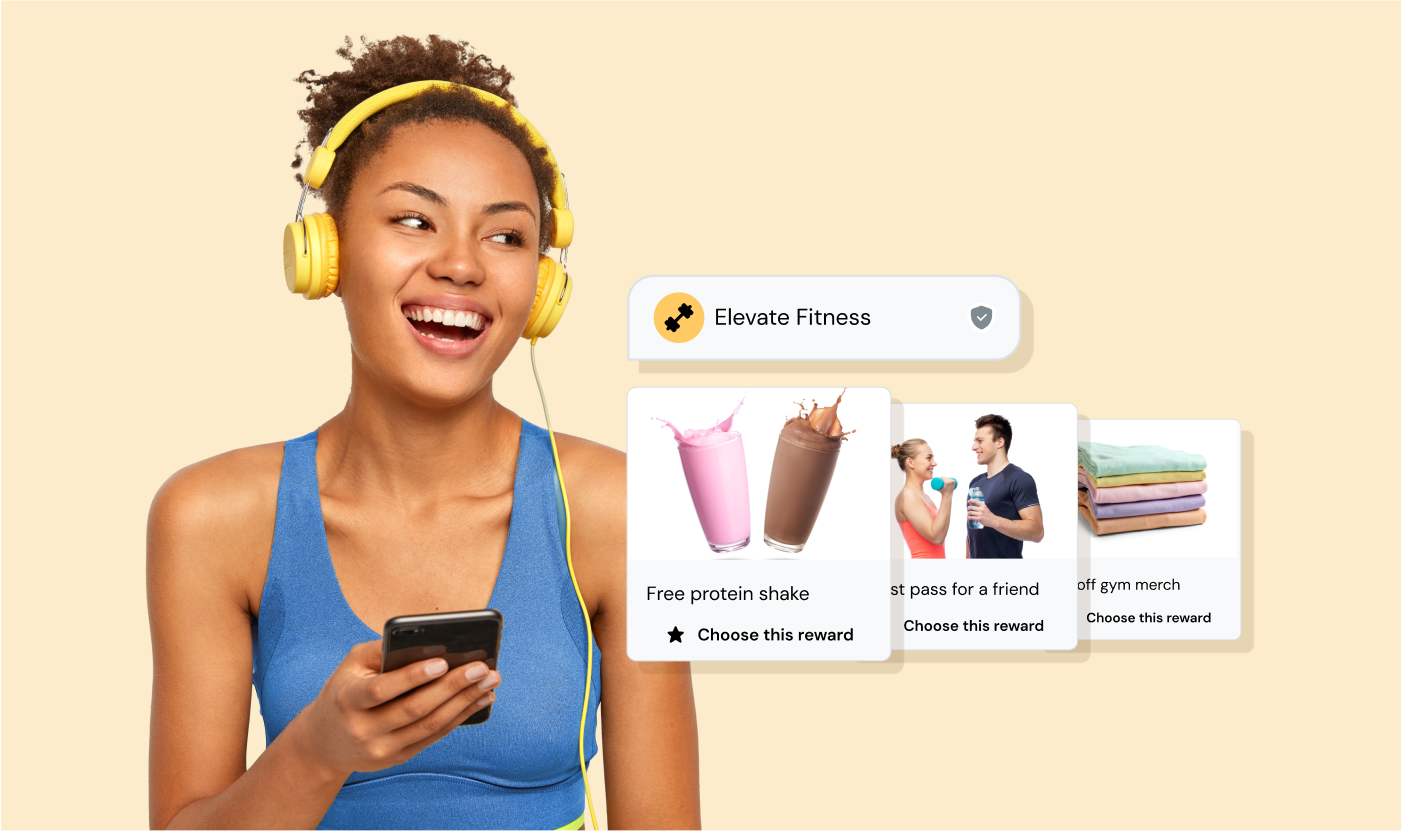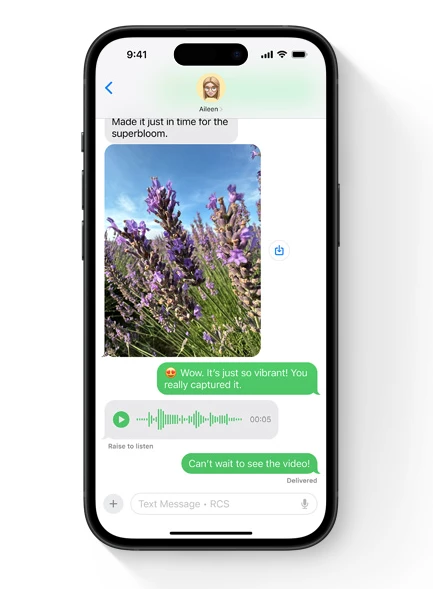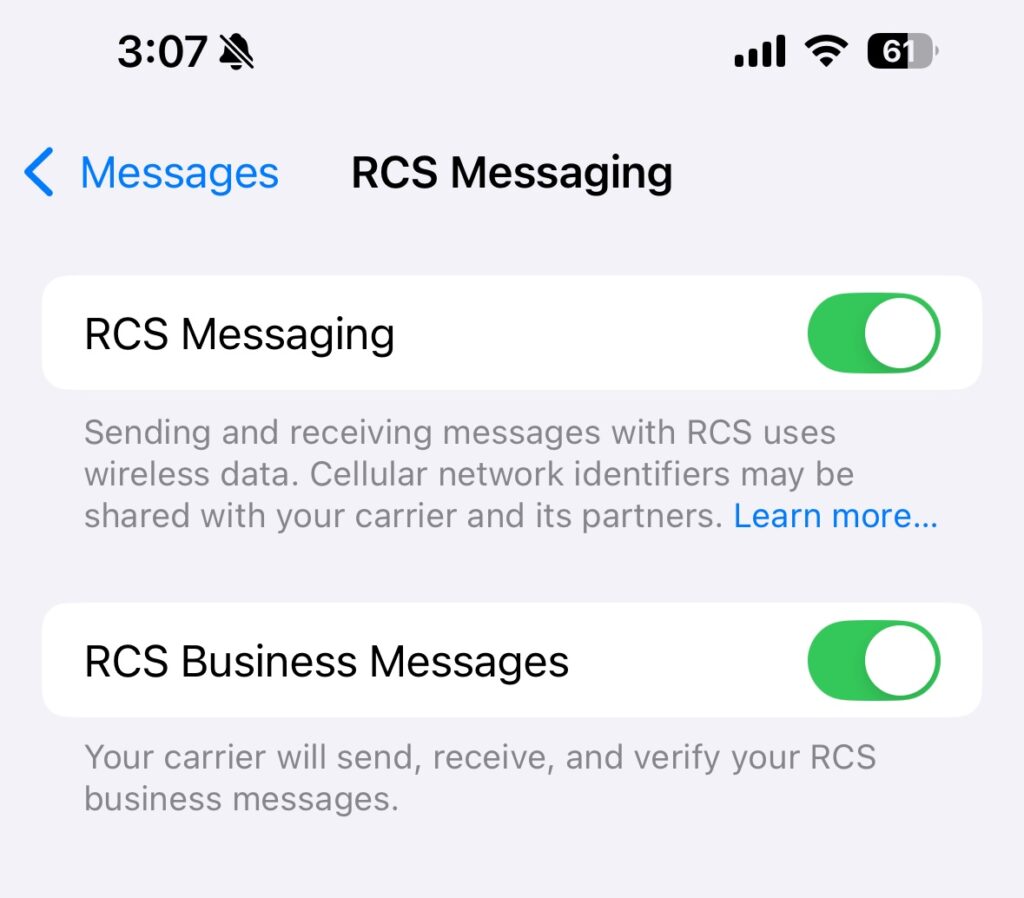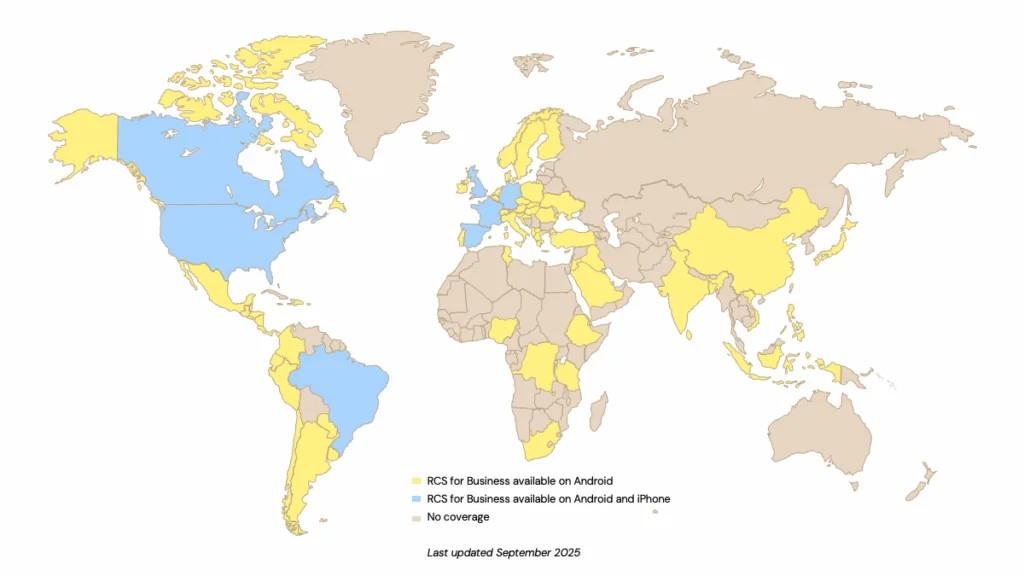Insights
Everything to know about Apple RCS support in 2025

Insights

After years of relying on SMS and MMS to send messages between iPhone and Android devices, Apple took a major step in modernizing cross-platform messaging by rolling out support for Rich Communication Services (RCS) towards the end of 2024. RCS brings high-quality media sharing, read receipts, typing indicators, and other interactive features for Apple users texting Android users, and vice versa.
For businesses, Apple RCS support opens the door for the ability to turn simple text messaging from random numbers into a branded, verified experience. Unlike SMS, which is limited to 160 characters of plain text per message, RCS supports rich business messaging features and offers a more secure, engaging way for brands and their customers to communicate.
This article breaks down everything we know about Apple’s RCS rollout, including timeline, supported features, what iOS 26 has in store, and the implications for both users and businesses.
Remember when Apple CEO Tim Cook suggested a reporter should buy his mom an iPhone rather than Apple adopt RCS? That was then. This is now.
For years, Apple resisted the RCS messaging standard, sticking instead with its iMessage ecosystem and ensuring a distinct – and occasionally frustrating – divide between green and blue bubbles. Basically, blue messages on an iPhone meant messages were sent via iMessage, which included high-quality media, read receipts, end-to-end encryption, and seamless group chats. And green bubbles? They represented SMS sent from Android phones and other non-iOS devices, with compressed images, clunky group chats, no encryption across devices, and no advanced features.
That changed in late 2023, when Apple confirmed in 9to5Mac that they’d support the RCS Universal Profile sometime in 2024. Their statement signaled a significant shift, promising a “better interoperability experience” compared to traditional SMS or MMS.
“Later next year, we will be adding support for RCS Universal Profile, the standard as currently published by the GSM Association. We believe RCS Universal Profile will offer a better interoperability experience when compared to SMS or MMS. This will work alongside iMessage, which will continue to be the best and most secure messaging experience for Apple users.”
At WWDC 2024, Apple confirmed its Messages app would support RCS in the iOS 18 update in fall 2024.
Why the change of heart? Apple hasn’t shared. But as The Verge reported in June 2024, “Apple was largely forced to support RCS in response to the mounting pressure from global regulators and competing companies.”
Apple officially introduced native person-to-person (P2P) RCS messaging support in some markets with the launch of iOS 18 in September 2024. Here’s what that looked like for iPhone users in iOS 18:

Apple jumped ahead from iOS 18 in 2024 to iOS 26 in 2025, which signals a milestone release that reshapes how people receive both messages and calls.
Here’s what’s changed:
Apple has confirmed support for RCS Universal Profile 3.0 in a future software update, which MacRumors expects to roll out at some point during the iOS 26 software cycle. That means RCS on iPhone will soon catch up to many iMessage-style features, like:
For now, Apple’s support for RCS messaging is limited to certain carriers in markets that have been selected by Apple, and who have also gone through Apple’s required testing and contract work.
Person-to-person (P2P) RCS is currently supported in these markets, and RCS for Business is also available in some cases:
For the latest availability, check out Apple’s support page for Europe, U.S./Canada, and APAC.
Clearly, Apple’s RCS rollout is picking up speed, and with each iOS update, the list of supported carriers and regions is growing – that’s a strong signal that RCS on iPhones is here to stay!
If you have iOS 18 or later in one of the regions above from a participating carrier, you can enable RCS in your iPhone’s Messages settings.

Once it’s on, you’ll get a richer messaging experience when texting Android users – with read receipts, typing indicators, and high-resolution media sharing. Look for the label “Text Message • RCS” in the message field to know it’s working.
RCS is a carrier-managed service. RCS messages are sent over Wi-Fi or cellular data where it’s supported.
So, we’ve talked about Apple’s support for peer-to-peer RCS – but what about business messaging?
With the release of iOS 18.1 in October 2024, Apple started supporting RCS for Business messaging (previously called “RCS Business Messaging” or “RBM”) on iPhones in select markets with specific carriers. In those markets (which we review below), businesses can send rich, branded messages directly to customers’ mobile inboxes on both iPhones and Androids.
In this short video, Miriam Liszewski explains that Apple supports RCS for Business on iPhones when carriers support it.
With Apple rolling out both RCS and RCS for Business support in select markets, it’s important to understand the difference – and why Apple supporting both matters.
In short, RCS enhances everyday texting between users, while RCS for Business transforms how businesses connect with their audiences.
Up until 2024, these capabilities were only available on Android smartphones. But now, with Apple in the mix, businesses will have an even better opportunity to reach a much broader audience.
While RCS for Business may look a little different on iPhones than on Android, the basic features are the same. Below is a quick feature comparison of the implementation of RCS for Business on iPhone and Android.
| Feature of RCS for Business | iPhone | Android |
|---|---|---|
| Read receipts | ||
| Typing indicators | ||
| Rich cards | ||
| Higher-resolution images and videos | ||
| Carousels | ||
| Branded messages | ||
| Suggested reply actions | ||
| Share location | ||
| Google Wallet integration | ||
| Request location | ||
| End-to-end encryption |
Check out the video to see RCS for Business in action on iPhone.
Video shows implementation of RCS for Business (previously called “RBM”) on an iPhone, including rich cards, carousels, and more. Recorded in November 2024.
While we don’t have a confirmed timeline for additional features or expanded market support, we know many businesses are excited by RCS for Business because of the richer experience it provides, more comparable to WhatsApp’s business solutions or Apple Messages for Business than SMS.
As of now, RCS for Business on iPhones is only available in select markets with certain carriers. And even in regions where RCS is live, not all carriers support it the same way. Some may support full business messaging (A2P), while others still don’t offer it at all.
In short: Whether your business can send RCS messages to your customers’ Apple devices depends on two things:
The map below shows regions where RCS for Business is supported in some capacity.

If your business operates in the U.S., you’re probably wondering about various carriers’ support. The answer? It depends – but many carriers support RCS for Business on both iPhones and Android devices. And more are joining all the time.
Does Verizon have RCS for iPhones? Sinch’s RCS Product Owner Miriam Liszewski explains how carriers like Verizon and T-Mobile have enabled both P2P and A2P RCS for both Android and iPhone devices.
And once a carrier supports RCS for Business, the messages just work – there’s no extra setup required by the user. Devices that have RCS enabled will automatically receive verified, branded business messages in their native messaging app.
Ready to get going with RCS? Great – you’ve got options.
Many businesses start by upgrading their existing SMS messages to RCS where it’s supported, while still delivering SMS when RCS text messaging isn’t available. It’s a simple, low-lift way to introduce secure, branded messaging into your existing workflows.
Others use tools like Conversation API or Sinch Engage to launch branded messaging experiences straight away.
In either case, before getting started, you’ll need to launch an RCS Agent and get approved by Google and/or a carrier. This process depends on if carriers support RCS in your market.
Pro tip: Sinch can help get your RCS Agent up-and-running, and get you onboarded with RCS quickly and easily. Reach out to us to get started.
Apple’s adoption of RCS and RCS for Business on iPhones is a big leap forward for messaging, with the potential to bring better messaging experiences to the two biggest mobile operating systems in the world.
We’re closely monitoring how Apple continues to roll out RCS messaging support and will keep you updated as we learn more. However it plays out, though, Apple’s support for RCS means you can expect more robust, feature-rich communication possibilities. The good news? You can rest assured that our platform is ready for this change.
In the meantime, here are some resources for you to learn more about RCS:
And if you’re ready to start with RCS, Sinch can help. Contact us to speak with a member of our team about how you can create a conversational messaging strategy your customers will love!